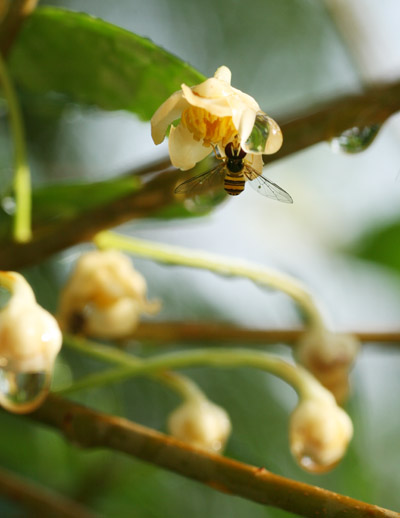 And then, the rains did come.
And then, the rains did come.
After making that last post early in the morning and going to bed, I was awoken by another storm, this one centered right overhead – at least, if the explosion of thunder that loosened my fillings was any indication. This one brought rain with it, a good soaking, so I’m no longer conflicted.
I have not been neglecting my arthropod subjects, even though I’m trying not to post the same things over and over again, and for the past few nights I’ve gone out and misted many of the plants that they’ve been living upon, almost entirely for their benefit. Thus, some of the photos you’ll see here are from the real rain, and some from my shamelessly staging a fake rain for the benefit of the bugs, taking advantage of the circumstances to get a few pics while I’m at it. Yes, I’m that crassly opportunistic.
I don’t even know what bush these flowers are from, and have little to search on, but the aroma is pleasant, and this hoverfly was quite happy. Whether the rain provoked the flowers into opening or not I cannot say – it appears like it might have, if this and two of the rose bushes are any indication.
Most of the time, after the plants have been misted (which I usually do at night to let it last longer, since the sun will evaporate it in minutes,) the arthropods will become visibly active, seeking out the moisture.

This little specimen, known as a harvestman or daddy longlegs or more properly from the order Opiliones, probably genus Leiobunum, scampered into the spray as it was occurring, which is fairly rare – most species seem to avoid it when it’s coming down but will emerge soon afterward.
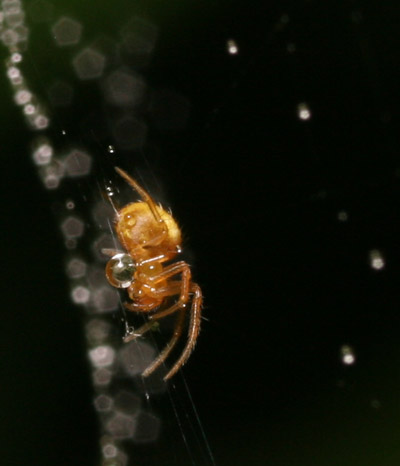 Spiders most often seek shelter, usually at one of the upper anchors of the web, but will resume position quickly, sometimes gathering drops that adhere to their bodies as they do so, though whether this is intentional to make it easy to drink, or incidental as they clamber past, is something I haven’t determined yet (and quite possibly won’t – who could tell if a spider is snagging dewdrops intentionally as it crawls across its web?) I have seen some spiders purposefully dislodging drops from the web, presumably to keep it invisible, while others seem to ignore it in the knowledge that it will evaporate quickly. Actually, there is probably no such knowledge – they just never evolved an instinct to worry about it because it never affected their survival. Let’s not credit too much cognition to the class.
Spiders most often seek shelter, usually at one of the upper anchors of the web, but will resume position quickly, sometimes gathering drops that adhere to their bodies as they do so, though whether this is intentional to make it easy to drink, or incidental as they clamber past, is something I haven’t determined yet (and quite possibly won’t – who could tell if a spider is snagging dewdrops intentionally as it crawls across its web?) I have seen some spiders purposefully dislodging drops from the web, presumably to keep it invisible, while others seem to ignore it in the knowledge that it will evaporate quickly. Actually, there is probably no such knowledge – they just never evolved an instinct to worry about it because it never affected their survival. Let’s not credit too much cognition to the class.
There are still half a dozen or so mantises that I can find at any given time, and they noticeably take advantage of the moisture when it appears, which is usually demonstrated in one of two ways.
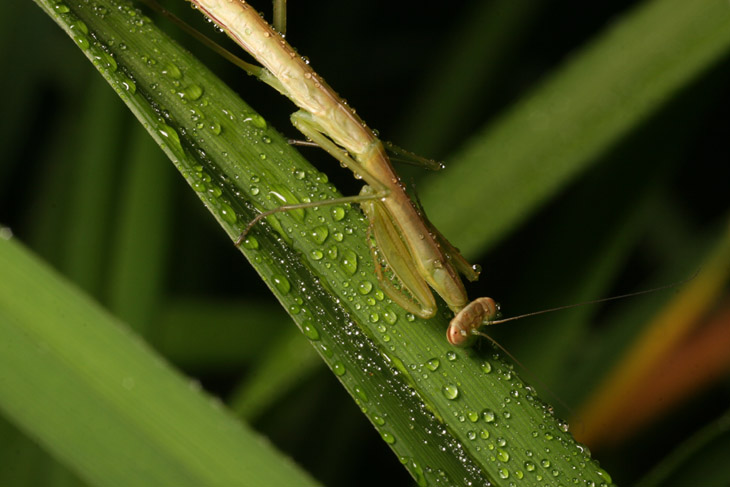
The most common seems to be when they slurp the dew up directly from the leaf, though getting a really good angle on this is hard, since they tend not to do it when a camera is looming at face level right in front of them – go figure. However, you can see where this one has already cleared a portion of the leaf from the adhering drops. I missed an opportunity the other night, when another had climbed up to a leaf and poked its head over the edge to sip up the moisture – I did not have the camera in hand at that moment.
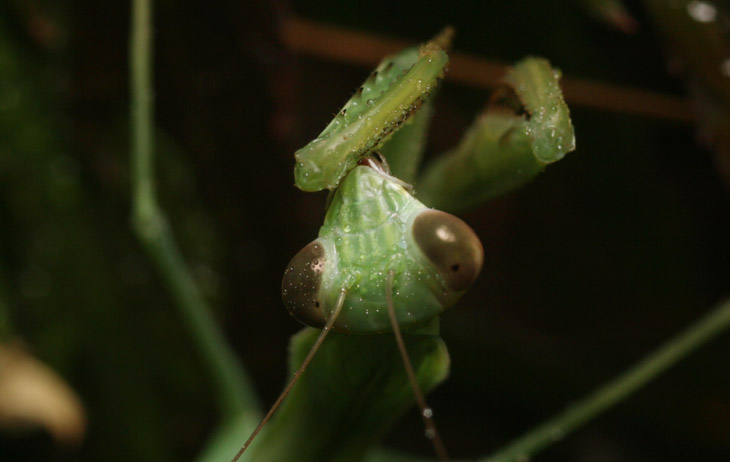
The other method is usually employed if they get caught in the mist, but not always. They’ll use a foreleg to clear the water from their eyes first, then from other areas of their body or just snag it from a surface, then suck it up off the leg. Perhaps because they’re in a more ‘ready’ position while doing this, but I’ve found it a lot easier to get these kind of images – they seem less self-conscious about danger nearby.
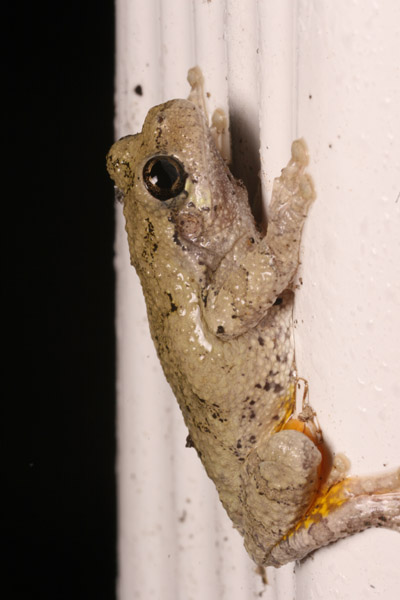 One little surprise appeared the other sweltering night, spotted on the downspout just after I misted the plants below, so I provided its own misting. This is likely a Copes grey treefrog (Hyla chrysoscelis) and they need the moisture, so it’s rare to see them out when it’s been so dry. Just to demonstrate my dudeness, not only did I provide a decent soaking, I turned on the deck light right overhead and left it on for a few hours in an attempt to provide more food for the little spud.
One little surprise appeared the other sweltering night, spotted on the downspout just after I misted the plants below, so I provided its own misting. This is likely a Copes grey treefrog (Hyla chrysoscelis) and they need the moisture, so it’s rare to see them out when it’s been so dry. Just to demonstrate my dudeness, not only did I provide a decent soaking, I turned on the deck light right overhead and left it on for a few hours in an attempt to provide more food for the little spud.
Not too long ago something laid eggs in the pond I’ve been working on out back, but it proved incredibly elusive so I never got to see what it was. I wasn’t sure if any of the eggs survived the mosquito larva filter, but there are tadpoles in there now so we’ll just have to see what develops. It could also be chorus frogs, peepers, or cricket frogs, all of which are common in this area.
This was a small average specimen, about 4 cm long, so that will provide a little scale for the next bit. As I was circling around to get a variety of photos, I noted a tiny grey arthropod of some kind up near an eye, small enough that I could make out no details either by eye or through the viewfinder, so I went in as tight as I could to get images that I would be blowing up later on.
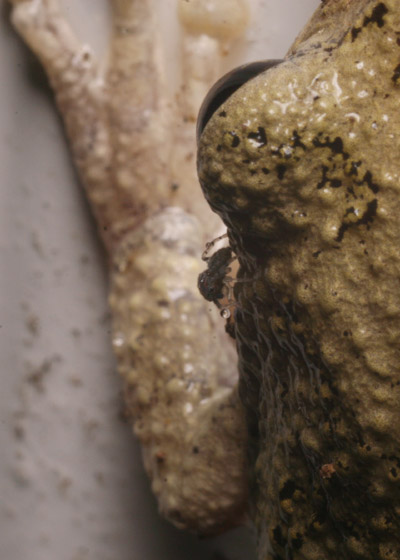 This little stowaway couldn’t be much larger than 1mm in body length, and by flashlight it remained hard to make out, though it could be seen perambulating around on Mt Frog here. If you look closely, you can see that it has its own supply of water, a tiny droplet adhering to its leg. But in a moment, it turned to face me, and the resulting tight crop confirmed what the other images had hinted at.
This little stowaway couldn’t be much larger than 1mm in body length, and by flashlight it remained hard to make out, though it could be seen perambulating around on Mt Frog here. If you look closely, you can see that it has its own supply of water, a tiny droplet adhering to its leg. But in a moment, it turned to face me, and the resulting tight crop confirmed what the other images had hinted at.
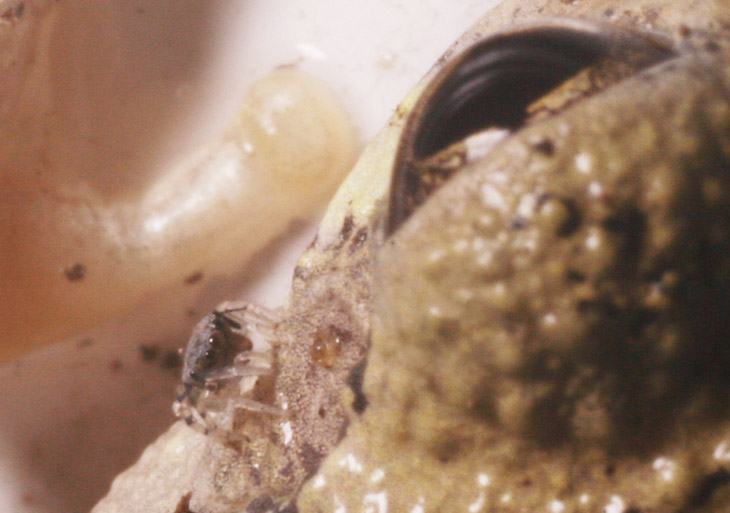
If the body shape wasn’t enough, that eye pattern determined that this was a tiny jumping spider, almost certainly a newborn. While I should have used the reversed 28-105 for this shot, which would have provided much better magnification, I was already pushing the limits in terms of position and lighting – not every macro subject is in ideal conditions (in fact, very few are.) The frog was completely unconcerned with the rider, only blinking once when the spider wandered to the corner of its eye, and wasn’t terribly concerned with my presence either, but they rarely are anyway – they’re a pretty easy species to photograph when they’re not actively hunting or looking for mates.
Returning to this morning immediately after the rain, we have a bizarre catch, which happens far more often than we probably imagine. The surface tension of water is an entirely different thing when you’re tiny.
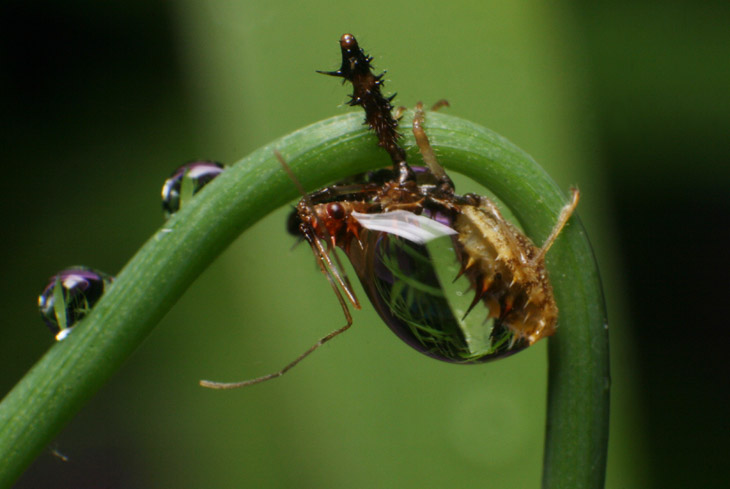
This assassin bug nymph, probably genus Sinea, was all set to weather the next week’s worth of irrepressibly hot conditions. While it was probably helped by the spiny body structure, when you’re 3-4mm in length, you can get away with carrying a water droplet the length of your entire body, though I suspect it wasn’t intentional. And it wasn’t just hanging there, because the bug was actively trying to avoid me and kept moving to the far side of the stem. But you have to appreciate how the water acts as a lens to show the plant behind it.
No, seriously, you have to. There’s no choice in the matter.



















































